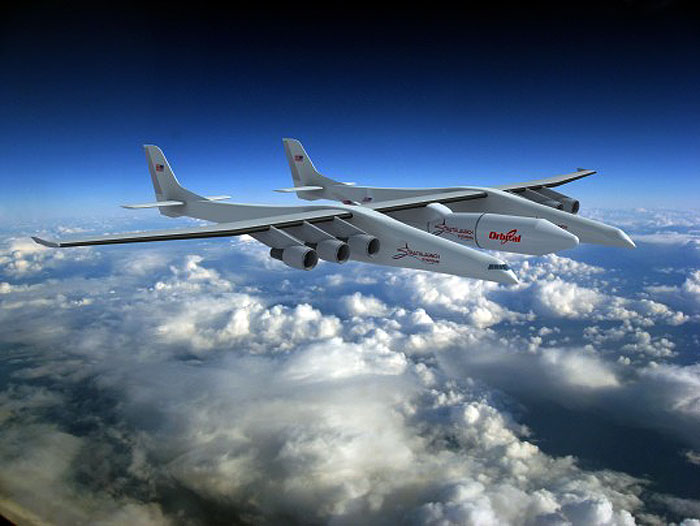.

Courtesy of stratolaunch - A rendering shows a Stratolaunch rocket slung below a plane that carries it to 30,000 feet before the two craft separate, allowing the rocket to be shot into space.
.
Ghaffari said Allen nursed the idea for Stratolaunch for nearly two decades and began studying it in earnest in conversations with Scaled Composites founder Burt Rutan around 2000. With Allen as financial backer, Rutan’s SpaceShipOne was launched from an aircraft in 2004 to become the first piloted civilian spaceship to make a suborbital flight above Earth’s atmosphere.
SpaceShipOne was regarded then primarily as proof-of-concept for the viability of space tourism at relatively affordable prices, and Scaled Composites is building a passenger spacecraft with funding from Virgin Group founder Richard Branson. Ghaffari, however, said Stratolaunch was always foremost in Allen’s thoughts: “SpaceShipOne was definitely a predecessor,” he said. Rutan has retired from Scaled Composites, but he is a Stratolaunch board member, as is former NASA Administrator Mike Griffin.
Orbital Sciences had been consulting for Stratolaunch since last year and formally joined the project in May. Orbital is the developer of Pegasus, the first air-launched civilian spacecraft able to put small payloads into low-Earth orbit. Orbital Sciences spokesman Barron Beneski said proven expertise in air launch was one of the “connecting fibers” that linked the company to Stratolaunch.
Stratolaunch has only two employees — Chief Executive Officer Gary L. Wentz Jr. and Chief Operating Officer Susan G. Turner — but Wentz estimated that close to 200 contractors are working on design and construction.
Wentz said project engineers are “looking at a multitude of potential challenges.” The host aircraft, with a 385-foot wingspan, will be made of composite materials, and the spacecraft will have three stages. The plane will drop the spacecraft at 30,000 feet and initiate a banked turn. Rocket ignition will come four to seven seconds later to give the aircraft enough time to get out of the way of the back blast. As for the rocket, the first stage, which is to be reusable, drops into the ocean; the second burns up in the atmosphere; the third puts the satellite into orbit, and eventually that third stage, too, burns up in the atmosphere.
A two-mile runway
Wentz, speaking from Stratolaunch’s headquarters in Huntsville, Ala., said the team has not yet decided whether the spacecraft will use liquid or solid fuel, and planners are still scouting airports for a likely base. Stratolaunch needs about two miles of runway to take off — about 50 percent more than any other commercial aircraft.
Wentz said the Kennedy Space Center’s Shuttle Landing Facility is the leading candidate, in part because infrastructure for both solid and liquid fuel is already in place. Planners are also looking at the Vandenberg and Edwards air force bases in California and at NASA’s Wallops Island Flight Facility in Virginia. The aircraft must also have access to other large airports in case of an emergency landing, and the company will need to obtain a commercial launch license from the Federal Aviation Administration.
Stratolaunch’s logistics are fairly simple and should offer considerable advantages over ground-launched competitors. Missions need not be automatically scrubbed because of bad weather, and the aircraftwould be able to launch its rocket above the clouds from almost any location. Also, clients would not have to wait in line to fly from oversubscribed terrestrial launch pads.
The physics of airborne space launches, by contrast, are elaborate, with many variables that affect the cost, frequency and reliability of flights. Wentz said the Stratolaunch team has not made all the calculations but expects the company will realize significant savings by “tweaking” the variables. Ground-based launches are just as complicated as air launches, but the science is much better understood.
One of Cape Canaveral’s attractions is that it is on the East Coast, next to the Atlantic Ocean. It is always desirable to launch to the east to capitalize on the direction of the Earth’s spin. The Earth travels about 1,000 mph west to east at the equator; you need to reach a speed of 17,000 mph to get to low-Earth orbit, so there’s no point in penalizing yourself 1,000 mph by heading in the wrong direction. Wentz said the team has also considered alternative sites closer to the equator, where this effect is more pronounced.
Also, a Stratolaunch flight would climb out of the first 30,000 feet of the Earth’s gravity well on jet fuel instead of much more expensive rocket fuel, and the spacecraft would be released in rarefied atmosphere with high tail winds to kick it forward.
Finally, Wentz said, the aircraft would be traveling nearly 300 mph when it launches the spacecraft, and “the goal is to maintain as much of the forward velocity as possible.” Traveling downrange, the rocket would ignite and rise at an angle of 12 to 15 degrees. The aggregate effect of all these forces is similar to the acceleration a javelin thrower gets by sprinting down the runway before throwing his spear. While the savings in energy over a ground launch is only 5 to 10 percent, Rutan said at the 2011 news conference, “this is huge” for space travel.
Quelle: Health & Science
5523 Views
